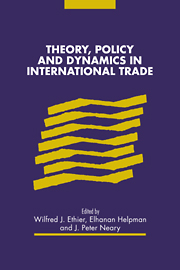Book contents
- Frontmatter
- Contents
- List of conference participants
- I Introduction
- II History, geography and the theory of trade
- III The structure of simple trade models
- IV Policy towards international trade
- V Trade, growth and dynamics
- 11 Prices of goods and factors in a dynamic stochastic economy
- 12 Capital market imperfections and the infant industry argument for protection
- 13 Endogenous real business cycles and international Specialization
- 14 Impact of government on growth and trade
- 15 Long-run production frontiers for the Jones specific-factors model with optimal capital accumulation
- 16 Hysteresis in the trade pattern
- Index
14 - Impact of government on growth and trade
Published online by Cambridge University Press: 16 March 2010
- Frontmatter
- Contents
- List of conference participants
- I Introduction
- II History, geography and the theory of trade
- III The structure of simple trade models
- IV Policy towards international trade
- V Trade, growth and dynamics
- 11 Prices of goods and factors in a dynamic stochastic economy
- 12 Capital market imperfections and the infant industry argument for protection
- 13 Endogenous real business cycles and international Specialization
- 14 Impact of government on growth and trade
- 15 Long-run production frontiers for the Jones specific-factors model with optimal capital accumulation
- 16 Hysteresis in the trade pattern
- Index
Summary
In the 1950s and 1960s, efforts to develop a theory of economic growth proceeded along two main, and largely independent, lines. On one hand, there was a line of research concerned with a theory of economic growth pertaining chiefly to those characteristics believed to be particular to developing countries. On the other hand, neoclassical growth theory was developed, stimulated by the seminal work of Solow.
Initially, the focus of those concerned with the economic growth of the developing countries was primarily upon ways of achieving more rapid capital accumulation in the context of a dual-economy, labor-surplus, model in which a variety of “structural rigidities” and market imperfections were thought to have been responsible for the economic backwardness of developing countries. Attention therefore centered on reasons for backwardness, and the role of government in overcoming market failures.
Neoclassical growth theory, by contrast, was developed on the assumptions that markets function well and that the production function (with at least labor and capital as inputs) had constant returns to scale. Growth in the long run could therefore originate only through technical progress.
Over time, the attention of those seeking a theory of development shifted from a primary concern with capital accumulation in dual economy models to a broader effort to understand the interaction of factor accumulation (including not only physical but also human capital) and government policies in the developing process. This research was stimulated in large part by the experience of developing countries.
- Type
- Chapter
- Information
- Theory, Policy and Dynamics in International Trade , pp. 237 - 251Publisher: Cambridge University PressPrint publication year: 1993

